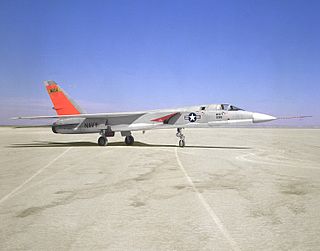
The North American A-5 Vigilante was an American carrier-based supersonic bomber designed and built by North American Aviation (NAA) for the United States Navy. Prior to 1962 unification of Navy and Air Force designations, it was designated the A3J Vigilante.

Strike Fighter Squadron 211 (VFA-211), nicknamed the "Fighting Checkmates", is an aviation unit of the United States Navy established in 1945. The squadron is based at Naval Air Station Oceana and is equipped with the F/A-18E Super Hornet.

Strike Fighter Squadron 213 (VFA-213) Blacklions is an aviation unit of the United States Navy based at Naval Air Station Oceana, Virginia. It was established in 1955 and is currently equipped with the F/A-18F Super Hornet. The squadron is assigned to Carrier Air Wing Eight and uses the radio callsign Lion.

Fighter Squadron 114 (VF-114) was a fighter squadron of the United States Navy that was active from 1945 through 1993. Nicknamed the "Aardvarks", it was based out of Naval Air Station Miramar, California. The squadron flew combat missions during the Korean War and Vietnam War. VF-114 was disestablished as part of the post-Cold War drawdown of forces on April 30, 1993.

Strike Fighter Squadron 143 (VFA-143), also known as the "Pukin Dogs," is a United States Navy strike fighter squadron based at Naval Air Station Oceana, Virginia. The Pukin Dogs are an operational fleet squadron and flying the F/A-18E Super Hornet. They are currently attached to Carrier Air Wing Seven and USS George HW Bush. They are currently at their homeport of NAS Oceana. Their radio callsign is Taproom.

Strike Fighter Squadron 97 (VFA-97), also known as the "Warhawks", are a United States Navy F-35C Lightning II squadron stationed at Naval Air Station Lemoore.Their tail code is "NE” and their radio callsign is Warhawk. It is the second operational non-training F-35C squadron in the Navy.

Naval Air Station Sanford was a naval air station of the United States Navy in Sanford, Florida, approximately 20 miles north of Orlando, Florida. Opening less than a year after the start of World War II, NAS Sanford's initial function was as an advanced training base for land-based patrol bombers, followed by carrier-based fighter aircraft. The air station briefly closed in 1946 and was placed in caretaker status until being reactivated in 1950. It eventually served as a Master Jet Base for carrier-based heavy attack and reconnaissance aircraft until 1969. After its closure, it reopened as civilian general aviation airport under various names with a non-Navy civilian airport identifier until finally transitioning to a scheduled air carrier airport under its current name of Orlando-Sanford International Airport.

Electronic Attack Squadron 131 (VAQ-131), also known as the "Lancers," is a United States Navy tactical jet aircraft squadron specializing in kinetic and non-kinetic Suppression of Enemy Air Defenses (SEAD). They are based at Naval Air Station Whidbey Island, flying the EA-18G Growler and are part of Carrier Air Wing 8, deploying aboard USS Gerald R. Ford. Their radio callsign is "Skybolt."

VAP-62 was a Heavy Photographic Squadron of the U.S. Navy. Originally established as Photographic Squadron Sixty-Two (VJ-62) on 10 April 1952, it was redesignated as Heavy Photographic Squadron (VAP-62) on 2 July 1956. The squadron was disestablished on 15 October 1969.

VFP-63 was a Light Photographic Squadron of the U.S. Navy. Originally established as Composite Squadron Sixty-One (VC-61) on 20 January 1949, it was redesignated as Fighter Photographic Squadron (VFP-61) on 2 July 1956. Redesignated as Composite Photographic Squadron Sixty-Three (VCP-63) on 1 July 1959 and finally redesignated as Light Photographic Squadron Sixty-Three (VFP-63) on 1 July 1961. The squadron provided a detachment of reconnaissance planes for each of the Carrier Air Wings of the U.S. Pacific Fleet. The squadron was disestablished on 30 June 1982.

RVAH-1 was a Reconnaissance Attack (Heavy) Squadron of the U.S. Navy. Originally established as Heavy Attack Squadron One (VAH-1) on 1 November 1955, it was redesignated as Reconnaissance Attack (Heavy) Squadron One (RVAH-1) on 1 September 1964. The squadron was disestablished on 29 January 1979.
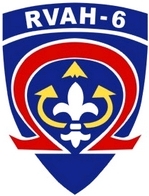
RVAH-6 was a Reconnaissance Attack (Heavy) Squadron of the U.S. Navy. Originally established as Composite Squadron Six (VC-6) on 6 January 1950, it was redesignated as Heavy Attack Squadron Six (VAH-6) on 1 July 1956 and was redesignated as Reconnaissance Attack (Heavy) Squadron Six (RVAH-6) on 23 September 1965. The squadron was disestablished on 20 October 1978.
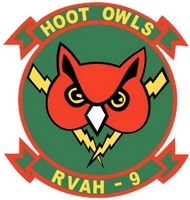
RVAH-9 was a Reconnaissance Attack (Heavy) Squadron of the U.S. Navy. Originally established as Composite Squadron Nine (VC-9) on 15 January 1953, it was redesignated as Heavy Attack Squadron Nine (VAH-9) on 1 November 1955 and was redesignated as Reconnaissance Attack (Heavy) Squadron Nine (RVAH-9) on 3 June 1964. The squadron was disestablished on 30 September 1977.

RVAH-7 was a reconnaissance attack (heavy) squadron of the U.S. Navy. Originally established as Composite Squadron Seven (VC-7) on 10 August 1950, it was redesignated as Heavy Attack Squadron Seven (VAH-7) on 1 November 1955 and was redesignated again as Reconnaissance Attack (Heavy) Squadron Seven (RVAH-7) on 1 December 1964. The squadron was disestablished on 28 September 1979.
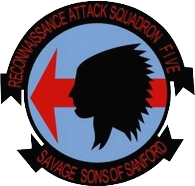
RVAH-5 was a Reconnaissance Attack (Heavy) Squadron of the U.S. Navy. Originally established as Composite Squadron Five (VC-5) at Naval Air Station Moffett Field, California on 9 September 1948, it was redesignated as Heavy Attack Squadron Five (VAH-5) on 1 November 1955 and was later redesignated as Reconnaissance Attack (Heavy) Squadron Five (RVAH-5) in May 1964. The squadron was disestablished on 30 September 1977.

RVAH-11 was a Reconnaissance Attack (Heavy) Squadron of the U.S. Navy. Originally established as Composite Squadron Eight (VC-8) on 3 December 1951, it was redesignated Heavy Attack Squadron Eleven (VAH-11) on 1 November 1955 and was redesignated as Reconnaissance Attack (Heavy) Squadron Eleven (RVAH-11) on 1 July 1966. The squadron was disestablished on 1 June 1975.
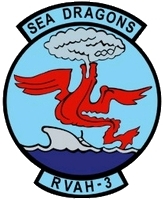
RVAH-3 was a Reconnaissance Attack (Heavy) Squadron of the U.S. Navy that served as the Fleet Replacement Squadron (FRS) for the RVAH community. Originally established as Heavy Attack Squadron Three (VAH-3) on 15 June 1956, it was redesignated as Reconnaissance Attack (Heavy) Squadron Three (RVAH-3) on 1 July 1964. The squadron was disestablished on 17 August 1979.

RVAH-12 was a Reconnaissance Attack (Heavy) Squadron of the U.S. Navy. The squadron was established on 1 July 1965 and disestablished on 2 July 1979.

RVAH-14 was a Reconnaissance Attack (Heavy) Squadron of the U.S. Navy. The squadron was established on 14 February 1968 and disestablished on 1 May 1974.

Fighter Squadron 111 (VF-111), also known as the Sundowners, was a fighter squadron of the United States Navy. Originally established as Attack Squadron 156 (VA-156) on 4 June 1955, it was redesignated VF-111 on 20 January 1959, the day after the original VF-111 was disestablished. The squadron was redesignated VF-26 on 1 September 1964, redesignated as VF-111 on 17 September 1964 and disestablished on 31 March 1995.




















